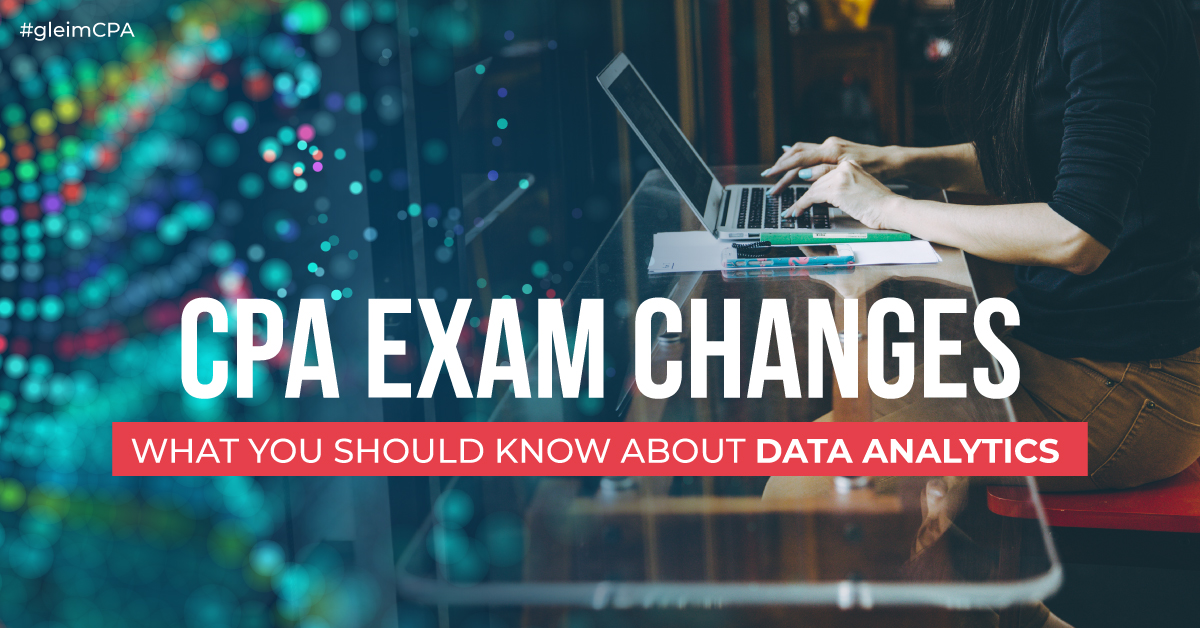Contact Us : 800.874.5346 International: +1 352.375.0772

The short answer: if you’re already studying, don’t change your plans.
When the AICPA released the CPA Exam Blueprints effective July 2019, they announced changes would be coming to how data analytics is tested. Since then, we haven’t seen many changes to or emphasis on data analytics; however, we expect changes to being rolling out early 2021.
Although the AICPA made some editorial and organizational changes to the Blueprints in 2019, you don’t need to take the exam sooner and there isn’t new material to study. The AICPA Summary of revisions to the Uniform CPA Examination Blueprints (July 1, 2019) clearly states:
Auditing and Attestation (AUD) – “The revisions expand upon or add more detail to the AUD Blueprint on audit data analytics. The revisions do not change the nature or scope of content eligible for testing in the AUD section. The audit data analytics concepts addressed in the revisions are covered by the existing AUD Blueprint and are currently eligible for testing.”
Business Environment and Concepts (BEC) – “The revisions are not intended to significantly change the content eligible for testing in the BEC section.”
The AICPA added the term “data analytics” to the AUD Blueprints, but the concept of data analytics was already present in both AUD and BEC. In short, we saw changes to the Blueprints, but not the exam content. Content that was tested beginning July 1, 2019, was already on the exam.
So, good news—if you’re currently studying with Gleim, you’re already studying the material you will see when you sit for your exam. We cover data analytics under “Analytical Procedures” within our AUD section, and under “Big Data and Analytics” within our BEC section. Don’t change your plans, don’t buy new materials, and don’t needlessly rush; you’re on track!
If you’re considering getting your CPA, or plan to begin studying soon, make sure you’re using a CPA review provider with the industry experience and expertise to
Gleim has been the best choice in CPA review for over 45 years! More top 10 accounting programs choose Gleim than any other review provider, and millions of CPA Exams have been passed with our help. Our proven approach and decades of experience have set the benchmark for exam prep. We’re so confident you will pass, we also offer a no-hassle Access Until You Pass® guarantee.
Want to pass with confidence and on the first try? Get Gleim CPA Review!
In case you’re curious, we’ll take a close look at the exact changes in the most recent CPA Exam Blueprints.
Below are the exact changes to AUD and BEC regarding audit data and analytics. These changes can also be found in the AICPA Summary of revisions to the Uniform CPA Examination Blueprints (July 1, 2019).
NOTE: In regard to how data analytics is tested on AUD, the AICPA has told Gleim and others that these Blueprint updates
SUMMARY: The term “data analytics” has been added to 2 paragraphs in the Section Introduction in order to explicitly state that it is a concept within the topic being tested. There is 1 new representative task in the section covering further procedures in response to identified risks to call out data analytics specifically, 1 new representative task in the section covering analytical procedures for obtaining evidence to call out data analytics specifically, and 2 new representative tasks in the section covering all other procedures that should be used to achieve audit objectives to call out data analytics specifically.
Section introduction
Area II, Group E, Topic 3 – Further procedures responsive to identified risks
Area III, Group C, Topic 1 – Analytical procedures
Area III, Group C, Topic 6 – All other procedures
SUMMARY: The BEC section of the Blueprints received some editorial changes which 1) added parenthetical examples to certain topics to give more guidance on the kinds of concepts that could be tested, 2) improved the consistency of some verbiage so candidates are not distracted by unimportant differences in terminology, and 3) reorganized an existing topic to help candidates better understand how IT topics will be tested (i.e., fundamental understanding, what are the risks associated with IT, and what are the controls that can be used to respond to those risks). Regarding item 3, specifically, a previously existing task within a Group B topic was split into two separate tasks. This was done in order to better distinguish three distinct approaches that make up the task as a whole.
Area IV
Now that you’ve seen the actual changes to the AICPA’s CPA Exam Blueprints, you might wonder why the topic created a lot of smoke, especially when there’s not really a fire. We asked ourselves the same question.
But Gleim has been in the business longer than any other provider, and we’ve seen many exam changes over the years. It’s not unusual for exam changes, or changes to the AICPA’s Blueprints, to cause a lot of excitement whether the changes are big or small. The CPA Exam is rigorous and intimidating. It’s easy for an opportunistic review provider to incite panic over these changes, urging candidates to rush into a purchase, and it’s just as easy for an inexperienced review provider to misinform candidates or fail to guide them through the changes.
Not every exam change is a big deal, but choosing the right review provider is. Earning your CPA is a critical step toward advancing your career and achieving your goals, and preparing for the exam should never be more confusing, expensive, or difficult than it needs to be.
Gleim’s advice? Always be sure that your review provider takes your success as seriously as you do.